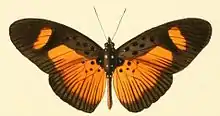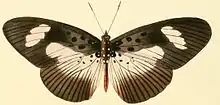Pseudacraea eurytus
Pseudacraea eurytus, the false wanderer, is a butterfly of the family Nymphalidae. It is found in Africa.
| Pseudacraea eurytus | |
|---|---|
 | |
 | |
| Scientific classification | |
| Kingdom: | |
| Phylum: | |
| Class: | |
| Order: | |
| Family: | |
| Genus: | |
| Species: | P. eurytus |
| Binomial name | |
| Pseudacraea eurytus | |
| Synonyms | |
| |
The wingspan is 60–68 mm for males and 65–75 mm for females. Adults are on wing year round, but mainly from December to May. There is a strong peak in late summer.[2]
The larvae feed on Mimusops obovata, Englerophytum magalismontanum, E. natalense and Chrysophyllum viridifolium.
Subspecies
- Pseudacraea eurytus eurytus (southern Senegal (Casamance) to Cameroon, Angola, Zaire, southern Sudan, Uganda, west of the Rift Valley in western Kenya and western Tanzania)
- Pseudacraea eurytus imitator Trimen, 1873 (South Africa, southern Mozambique)
- Pseudacraea eurytus conradti Oberthür, 1893 (Kenya: east of the Rift Valley, eastern Tanzania, Malawi, northern Mozambique)
- Pseudacraea eurytus obscura Neave, 1904 (Uganda)
- Pseudacraea eurytus mimoras Ungemach, 1932 (south-western Ethiopia)
Genetic Underdominance
False wanderers display a rare example of stable genetic Underdominance. This species possesses two alleles which each confer an appearance similar to that of another local butterfly species that is toxic to its predator. Individuals who are heterozygous for this trait appear to be intermediate in appearance and thus experience increased predation and lowered overall fitness, since false wanderers heavily rely on Batesian mimicry for survival.[3]
References
- "Pseudacraea Westwood, [1850]" at Markku Savela's Lepidoptera and Some Other Life Forms
- Woodhall, Steve (2005). Field Guide to Butterflies of South Africa. Cape Town, South Africa: Struik. ISBN 978-1-86872-724-7.
- Brauer, Fred; Kribs, Christopher (2015). Dynamical Systems for Biological Modeling: An Introduction. CRC Press. p. 399.
| Wikispecies has information related to Pseudacraea eurytus. |
| Wikimedia Commons has media related to Pseudacraea eurytus. |